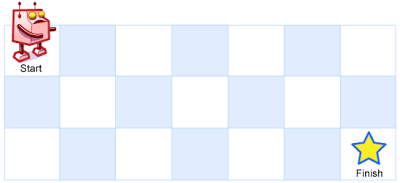62. Unique Paths
Problem¶
There is a robot on an m x n grid. The robot is initially located at the top-left corner (i.e., grid[0][0]). The robot tries to move to the bottom-right corner (i.e., grid[m - 1][n - 1]). The robot can only move either down or right at any point in time.
Given the two integers m and n, return the number of possible unique paths that the robot can take to reach the bottom-right corner.
The test cases are generated so that the answer will be less than or equal to 2 * 10**9.
Example 1:
Input: m = 3, n = 7
Output: 28
Example 2:
Input: m = 3, n = 2
Output: 3
Explanation: From the top-left corner, there are a total of 3 ways to reach the bottom-right corner:
- Right -> Down -> Down
- Down -> Down -> Right
- Down -> Right -> Down
Constraints:
1 <= m, n <= 100
Solve¶
Dynamic programming¶
Bottom up loop¶
We can spot a Recursive formulation, that we can calculate later answer by combining previous result uniquePaths:
With the most basic answer:
The final implement:
| Time Submitted | Status | Runtime | Memory | Language |
|---|---|---|---|---|
| 09/03/2023 11:19 | Accepted | 38 ms | 16.4 MB | python3 |
class Solution:
def uniquePaths(self, m: int, n: int) -> int:
cacheUniquePaths = [[0 for j in range(n+1)] for i in range(m+1)]
for rowID in range(m):
for columnID in range(n):
if rowID == columnID == 0:
cacheUniquePaths[0][0] = 1
continue
currentUniquePath = 0
aboveBlockUniquePath = 0
if rowID >= 1:
aboveBlockUniquePath = cacheUniquePaths[rowID-1][columnID]
currentUniquePath += aboveBlockUniquePath
beforeBlockUniquePath = 0
if columnID >= 1:
beforeBlockUniquePath = cacheUniquePaths[rowID][columnID-1]
currentUniquePath += beforeBlockUniquePath
cacheUniquePaths[rowID][columnID] = currentUniquePath
return cacheUniquePaths[m-1][n-1]
We can local test using this main function
def test():
a = Solution()
# Example 1:
m = 3
n = 7
result = 28
out = a.uniquePaths(m,n)
print("Test 1 is", out == result)
# Example 2:
m = 3
n = 2
result = 3
out = a.uniquePaths(m,n)
print("Test 2 is", out == result)
# Example 3:
m = 1
n = 1
result = 1
out = a.uniquePaths(m,n)
print("Test 3 is", out == result)
if __name__ == "__main__":
test()
Created : September 3, 2023
